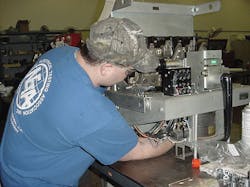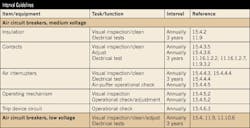During my career in the electrical industry, I’ve seen and heard so many dangerous misconceptions that I thought it would be worthwhile to share a few of them as lessons learned. I still find it amazing what so many smart, yet uninformed, men and women can believe without knowing why. Although I’ve limited this article to five incorrect assumptions, I can think of several more. I’m sure you can too. Please feel free to share your feedback and personal experiences on electrical urban legends in the comment section after this article.
1. The Neutral Isn’t Energized
I discovered this misconception isn’t true through personal experience. The problem with experience, as my father would often say, is that it is what you get right after you really need it. I was working in a power plant office replacing a ballast on a light fixture. Because this was the 1970s, electrical safety was generally ignored for anything 480V and below. The room was a large secretarial area, featuring a long string of lights connected together in a drop ceiling — with probably 20 or more fixtures connected to the same circuit. Today, we would turn the light switch off, lock it out, and change the ballast de-energized. Back then, however, “real” electricians didn’t turn power off — or, as my boss would say, “You’re trained to work it hot. So work it hot!”
As I gazed upon the wiring, I still remember thinking, “If I cut the black wire, it’s hot. I don’t have any twist-on wire connectors, so I’ll cut the neutral just to be safe.” I vaguely remember cutting the white neutral wire and seeing a spark. The entire string of ballasts discharged as soon as I made the cut. I believe they discharged to my nose, considering that I had a small scorch mark on the end of it later. Because I was already very sweaty, standing on an aluminum ladder in a drop ceiling, I became a pretty good conductor. The muscle spasms hurled me through three panels of the drop ceiling, and I landed on top of a secretary’s desk. Stunned — either from receiving the shock or having the wind knocked out of me (I don’t remember) — I clearly recall the secretary yelling at me to get off of her desk. I told her I would if I could, but I couldn’t.
I was written up later — not for an unsafe act, but for impeding the secretary from performing her job. When the plant manager asked if I had learned anything, I told him, “Yes, I need to get off the desk quicker.” He seemed satisfied with that answer.
Bottom line: The neutral is the return path for the electrical current. Just because the NEC defines it as the “grounded conductor” does not mean it’s not energized.
2. Overhead Service Drop Conductors are Insulated
They do have a black covering on them, so they must be insulated, right? Probably not. Conductors entering a building will be insulated for the voltage and shielded (Note: Older 4,160V installations may not have shielded cable). So what’s the black covering on overhead lines? It’s referred to as a “jacket.” Its purpose is to protect the cable conductor from weathering and external damage, but more than likely it will not insulate to the voltage.
Higher-voltage conductors (with no insulation covering) will have a region of ionized gas around them, where the electrons from the air molecules have been knocked out of their orbits and are spinning around inside the ionized gas. If someone were to break the plane of this ionized gas, it would be the same as making direct contact with the conductor. Those free electrons would use the person’s body as the path to ground. The higher the voltage, the larger the region of ionized gas. This is why linemen use live line tools when working on energized overhead lines — to place themselves outside the area of ionized gas.
Contact with overhead power lines is the No. 1 cause of electrocution in the United States, according to the CDC/NIOSH. Be aware of the hazards and risks associated with any task, especially those near overhead lines. Also be aware that at higher voltages, a voltage can be induced into any metallic, ungrounded object that is within its expanding and contracting magnetic field. In an outdoor substation environment, if it’s not grounded, consider it energized.
Bottom line: If you are not trained and experienced as a lineman, maintain a minimum of 10 ft from you (or anything held by you) to any overhead line. If the line is above 72.5kV line-to-line, increase that distance in accordance with NFPA 70E Table 130.4(C)(a).
3. That Untested, Unproven Circuit Breaker Will Trip Every Time
Okay, no one would actually say that, but they certainly act like it’s true. Men, women, dogs (not sure about cats) will walk up to a circuit or piece of electrical equipment and work on it as if the circuit breaker upstream is a sure-fire bet to operate 100% in accordance with the manufacturer’s specifications. Really? I can understand the dog, but people should have a bit better recognition of the facts.
Numerous studies have shown that if circuit breakers are left in service and not operated, their chances of operating correctly get less and less with each passing year. Gary Donner with Tony Demaria Electric in Wilmington, Calif., who is a former Shell Oil Co. employee, has information on this issue first-hand. According to Donner, Shell performed a study that indicated when circuit breakers sat undisturbed for years, they would not meet manufacturers’ specifications. After three to five years of service, 30% of the circuit breakers malfunctioned. After seven to 10 years, 50% of the circuit breakers malfunctioned, and after 17 to 20 years, the number was in the high 90th percentile. Donner says that study was lost during some work site transitions and is no longer available — chalk it up to hearsay, if you like.
The Reliability Subcommittee of the IEEE Industrial and Commercial Power Systems Committee, in IEEE Standard 493 (the Gold Book), conducted a survey that included 1,469 failures of electrical equipment. Survey respondents were asked to describe their opinion of the maintenance quality in their plant. Inadequate maintenance was blamed for 16.4% of the failures. Table 5-1 in Std. 493 shows the facility’s maintenance quality vs. number of failures. It’s interesting to note that 18.1% ranked their maintenance program as “fair,” and 32.8% of the programs were ranked as “poor.” This survey included all electrical equipment, of which circuit breakers were a part. Even taking an optimistic view of that data, 25% to 30% of the maintenance for installed circuit breakers could be considered questionable (Photo 1).
In the largest survey of its kind to date, NETA-member (interNational Electrical Testing Association) companies were asked to participate in a survey on the causes of circuit breaker failures. The survey data and conclusions (340,000 results) were provided in a paper presented at the 2008 NETA PowerTest Conference. The NETA survey showed that 22% of the circuit breakers had an issue with the overcurrent protective device that would have affected its operation, and 10.5% of the circuit breakers did not function at all! Of the circuit breakers that had performance issues, 42.8% had mechanical issues — and more than half of those were related to lubrication. All three surveys point in the same direction and support each other.
How often should circuit breakers be maintained, and what should be done to them? There are two sources for answers: ANSI/NETA MTS (Maintenance Testing Specifications)-2011 and NFPA 70B-2013, “Recommended Practice for Electrical Equipment Maintenance.” Both make recommendations as to frequency and what maintenance is required of electrical devices, but the ANSI/NETA MTS also provides specifics on what the results should be. The Table is an excerpt from NFPA 70B, Annex L, “Maintenance Intervals.”
What is a reliable method to determine if the circuit breakers have been maintained? The 2013 edition of NFPA 70B, “Section 11.27 Test or Calibration Decal System,” states, “11.27.1 General. After equipment testing, device testing, or calibration, a decal on equipment, in conjunction with test records, can communicate the condition of electrical equipment to maintenance and service personnel. This can be important for assessing the hazard identification and risk assessment for electrical safety procedures as well as the condition of electrical equipment.” Suggested decals are shown in the top row of the Figure.
Bottom line: Don’t assume a piece of equipment is going to operate properly unless it’s been regularly inspected, maintained, and tested.
4. You Only Need to Read Chapter 1 in NFPA 70E
Here’s another misconception no one would probably say aloud, but their actions indicate otherwise. After reading misconception No. 3 above, it is clear that maintenance, especially of overcurrent protective devices, is crucial to the safe operation and maintenance of electrical systems. It is important enough that the NFPA 70E Technical Committee started recognizing it is a problem beginning with the 2009 edition of NFPA 70E and adding more on that subject in the 2012 edition:
• 130.5 Arc Flash Hazard Analysis — “Informational Note No. 1: Improper or inadequate maintenance can result in increased opening time of the overcurrent protective device, thus increasing the incident energy.”
• 130.5 Arc Flash Hazard Analysis — “Informational Note No. 4: For additional direction for performing maintenance on overcurrent protective devices, see Chapter 2, Safety-Related Maintenance Requirements.”
Chapter 2, Section 205 has many important requirements, such as:
• “205.2 Single-Line Diagram. A single-line diagram, where provided for the electrical system, shall be maintained in a legible condition and shall be kept current.”
• “205.3 General Maintenance Requirements. Electrical equipment shall be maintained in accordance with manufacturers’ instructions or industry consensus standards to reduce the risk of failure and the subsequent exposure of employees to electrical hazards.”
• “205.4 Overcurrent Protective Devices. Overcurrent protective devices shall be maintained in accordance with the manufacturers’ instructions or industry consensus standards.
Maintenance, tests, and inspections shall be documented.”
These requirements are just the tip of the iceberg. Chapter 2, as well as the annexes, contain important information to keep workers safe. It’s not just safe work practices; if the electrical power system is not properly installed and maintained, it’s not safe to operate or work on. Period!
Bottom line: If the requirements of Chapter 2 are not met, Chapter 1 has little or no worth. What about that expensive arc flash study? It’s not reliable unless you maintain your equipment (Photo 2). This may sound harsh, but it’s the truth.
5. Low-Voltage Will Only Give You a Tingle, Nothing More
Well at least that’s what usually happens, right? Typically when we are shocked, electrical current passes from our hand to our foot. That means the electrical current must also pass through socks, shoes, and whatever the floor covering may be (dry concrete is not a good ground, by the way) before it actually goes to ground. These are additional layers of resistance that tend to reduce current flow through a person’s body. According to IEEE Standard 80, “Guide for Safety in AC Substation Grounding,” the average man has about 1,000Ω resistance. For 120V contact, Ohm’s Law shows 120mA of current flow. This may not seem like much current, but according to a study conducted by Dr. Charles Dalziel in 1961, it only takes 75mA of current for a duration of 5 sec to cause a person’s heart to fibrillate. This is considered to be the lower threshold limit for ventricular fibrillation. As the voltage increases, the chances of fibrillation also increase.
No one would willingly hold onto an energized conductor for 5 sec, but what if that person was working in an area or position where he could not free himself? What if he contacted the energized conductor or circuit part and could not release it (muscle contractions begin at about 16mA)? This means he could be in contact for far longer than 5 sec. If the worker has wet shoes and socks — and is standing on moist or wet ground — his body resistance can drop to just a few hundred ohms, causing more injury in a shorter period of time.
Bottom line: Rubber insulating gloves and leather protectors keep a worker safe from shock and protect the hands in case of an arc flash. If something is so complicated that gloves can’t be worn, why do it energized?
In summary
There are many more common misconceptions that could be discussed, but that would take a book, not an article. Workers, their supervisors, and managers must take an active role in educating all electrical workers, especially those who may not normally be considered electrical workers, such as HVAC technicians and I&C technicians. If any worker has to work on or near energized electrical conductors and circuit parts rated above 50V to ground, he would be considered a qualified worker.
Younger electrical workers entering the trade often observe older, more experienced workers to see how they perform tasks. That means the veterans must make special efforts to reinforce safe work practices — not demonstrate how crafty they are. I don’t think anyone wants to be responsible for someone else being injured or killed simply because he was too lazy to show others the right way to perform a hazardous task.
Safety should be on every electrical worker’s mind at all times. Work pressures, home situations, and on-the-job distractions can make that difficult. Being aware of an issue allows a person to be on guard to prevent that issue from causing a major problem. Don’t let urban legends or electrical fairy tales sidetrack your safety knowledge.
White is director of training for Shermco Industries in Irving, Texas. He can be reached at [email protected].







